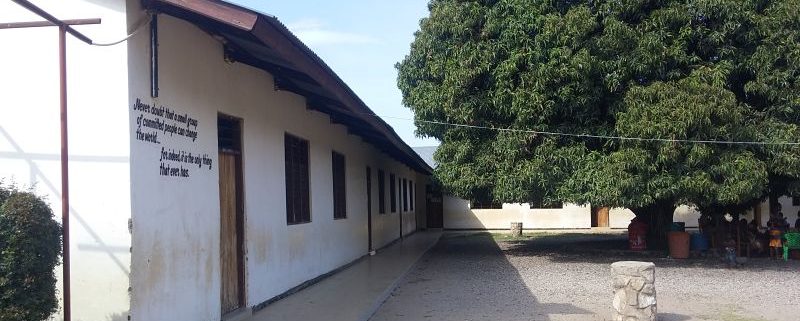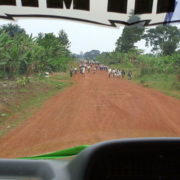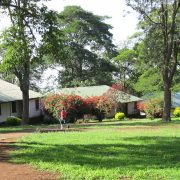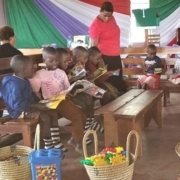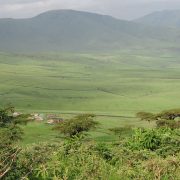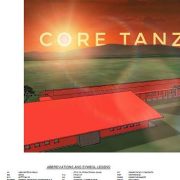Trip Update from Katoke
On Thursday at mid-day we left Bunda and headed to the Mainsprings center at Kitongo Village on the south shore of Lake Victoria. Mainsprings began as a refuge for girls, but now also runs a primary and secondary school, provides healthcare to local villagers, and operates a thriving permaculture farm. After a thorough tour of the campus we watched the girls’ basketball team practice, in awe that they could run back and forth on the court in heat that had us withering just from walking around. Some of the girls showed lots of promise and we were told that a few had been selected to attend a national basketball camp in Arusha. After basketball practice, we were invited to attend the daily meeting and prayer time at the girls’ refuge. The highlight of that for me was the beautiful a cappella singing that opened the session. After the meeting we had dinner with the girls—rice, beans, and greens from the garden—and then retired to the guesthouse on campus, where we spent the night.
Friday ended up being a long day of driving—much longer than we had anticipated due to a variety of complications. Our travel had already started to slow down a bit after we received a ticket the previous day for not stopping at a crosswalk. Apparently, a new law had just gone into effect requiring all cars to stop at crosswalks, whether or not there is a pedestrian waiting to cross. There are crosswalks at every village and also at every school. So except when we were driving through game reserves there were lots of crosswalks, and therefore, lots of stops. Another delay was road construction. We’d heard the shortcut road to the ferry across the bay south of Mwanza was under construction, but instead of one lane or the other being closed for short segments as we expected, the entire 15-mile road was closed so we had to travel on a makeshift service road that was rutted and bumpy and very slow. We arrived at the ferry dock to discover that one of the three ferries was out of service, so there were lots of cars and trucks waiting to cross. Two ferries came and went before we were able to board. By the time we finally made it to our destination, Katoke-Lweru Secondary School about an hour south of Bukoba town, it was too late to do any touring. After enjoying the meal they had prepared for us, we settled in at their guesthouse for the night.
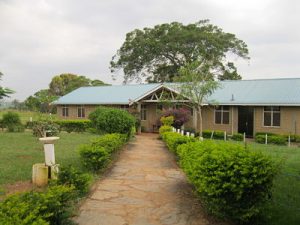
Administrative block at Katoke-Lweru, made with ISSBs
Katoke-Lweru is supported by an Anglican aid organization based in Australia. Their volunteer Australian builder, Kevin, conducted most of our tour the next morning. This was extremely helpful, since we could ask all sorts of questions, for example, why they chose particular materials and where they got them. We were very interested to learn that the older buildings on their campus were constructed from the same interlocking stabilized soil blocks (ISSB’s) that we have been planning to use to build Twegashe School.
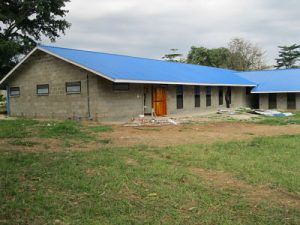
new buildings at Katoke-Lweru constructed with cement blocks
Kevin explained to us that they had been having some problems with moisture absorption by ISSB walls that were not protected by eaves. For this reason, they chose to use hollow cement blocks instead of ISSBs for the buildings currently under construction. Their block-making machine was diesel-powered, but Kevin said he thinks hand-operated machines are available. Although the mix for these blocks uses a lot more cement than the stabilized soil blocks, because they are hollow the total amount of material used is a lot less. In addition, the hollow blocks allow rebar to be placed vertically within the walls, eliminating the need for the periodic reinforced cement columns that would be required with ISSBs to provide strength in the event of an earthquake. In light of this new information we’re now faced with a decision about which of these two systems to use—but rather too many alternatives than too few!
Katoke-Lweru was the last of our scheduled school visits. We left the school in the late morning and headed to Bukoba town to do some shopping before making our way to Bushasha Village.

